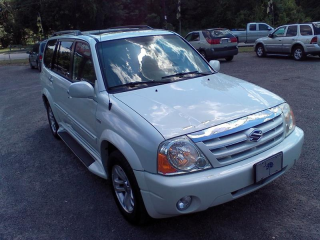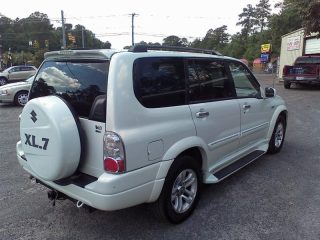The Good
The 2004 Suzuki XL7 offered practical advantages like standard seven-passenger seating and a competitive price. Its robust body-on-frame construction provided a durable feel, and the available V6 engine delivered decent power for its size. For emotional buyers, it presented an economical way to accommodate a larger family, while practical buyers appreciated its SUV capability for light off-roading or towing and its strong value proposition in the used market.
The Bad
Potential buyers of the 2004 Suzuki XL7 should watch out for its relatively dated interior design and limited refinement compared to some competitors. Fuel economy is not its strong suit, and parts availability can be a concern due to Suzuki's departure from the US market. Rust on the frame and body, particularly in salt-belt regions, is another common issue to inspect thoroughly.
2004 Suzuki XL7: Quick Overview
Here is a bullet-point summary of the 2004 Suzuki XL7's key specifications:
- Engine Options:
- 2.7L DOHC V6 (standard across all trims)
- Horsepower:
- 185 hp @ 6000 rpm
- Torque:
- 184 lb-ft @ 4000 rpm
- Fuel Economy (EPA estimates):
- 2WD Automatic: 17 MPG City / 22 MPG Highway
- 4WD Automatic: 16 MPG City / 21 MPG Highway
- 2WD Manual: 17 MPG City / 22 MPG Highway
- 4WD Manual: 16 MPG City / 21 MPG Highway
- 0-60 MPH Times:
- Approximately 9.5 - 10.5 seconds (V6 models, varies slightly by transmission and drive type)
- Towing Capacity:
- Up to 3,000 lbs (when properly equipped, with automatic transmission)
- Trim-Level Features:
- Base: Standard features include air conditioning, power windows and locks, a CD player, remote keyless entry, and 16-inch steel wheels. All models came with seven-passenger seating.
- Plus: Adds features like 16-inch alloy wheels, cruise control, a roof rack, and upgraded cloth upholstery.
- Touring: The top-tier trim, offering amenities such as automatic climate control, heated front seats, leather seating surfaces, a premium sound system with an in-dash CD changer, fog lights, and a power sunroof. Navigation was not commonly offered as a factory option for this model year. Four-wheel drive was available across all trim levels as an option.
2004 Suzuki XL7 Specifications
Vehicle Information
| Year | 2004 |
| Make | Suzuki |
| Model | XL7 |
| Trim | - |
| Style | Hard Top |
| Type | - |
| Category | - |
Manufacturing Details
| Made In | - |
| Manufacturing City | - |
Dimensions
| Doors | - |
| Curb Weight | - |
| Gross Vehicle Weight Rating | - |
| Overall Height | - |
| Overall Length | - |
| Overall Width | - |
| Wheelbase Length | - |
| Standard Seating | - |
Engine & Performance
| Engine | - |
| Engine Size | - |
| Engine Cylinders | - |
| Transmission | - |
| Transmission Type | - |
| Transmission Speeds | - |
| Drivetrain | - |
Additional Features
| Anti-Brake System | - |
| Steering Type | - |
Pricing
| Manufacturer Suggested Retail Price (MSRP) | - |
| Invoice Price | - |
| Delivery Charges | - |
Vehicle History Report
Specifications
History
Events
History Check
Check
Check
Check
Check
Listings
Recalls
Check
Analysis
What Problems Does the 2004 Suzuki XL7 Have?
The automatic transmission can be a source of problems, with reports of harsh shifting, slippage, or complete failure, especially in higher mileage examples. The four-wheel-drive system, while generally robust, can have issues with the front axle or transfer case, often related to neglect of fluid changes.
For the suspension, owners frequently report worn ball joints, control arm bushings, and strut mounts, leading to clunking noises and poor handling. Electrical issues, such as faulty window regulators or dashboard warning lights, are also not uncommon. Rust is a significant long-term concern, especially on the frame, suspension components, and even the body panels, particularly in regions that use road salt.
As for recalls, a notable recall (NHTSA Campaign Number: 06V327000) was issued for certain 2001-2006 XL7 models regarding a potential issue with the brake master cylinder retaining clip, which could allow the master cylinder pushrod to separate from the brake pedal. This could result in loss of braking ability. Another recall (NHTSA Campaign Number: 06V085000) involved the fuel pump gasket, which could leak fuel and pose a fire risk. Prospective buyers should always check if these or any other relevant recalls have been addressed.
How long will the 2004 Suzuki XL7 last?
Long-term durability is often hampered by issues such as timing chain guide wear, which requires significant repair, and potential automatic transmission failures if neglected. Rust, especially on the frame and critical undercarriage components, is a major weakness that can limit the vehicle's lifespan in corrosive environments. Neglecting suspension component replacement can also lead to accelerated wear and safety issues, ultimately reducing its service life. Regular inspections and preventative maintenance are key to extending the XL7's years of service.
What Technology & Safety Features are Included?
Driver-assistance features were virtually nonexistent by today's standards. There were no advanced systems like stability control, traction control, blind-spot monitoring, or forward collision warning. The primary driver aid was a standard anti-lock braking system (ABS), which was an important safety enhancement for the time. Power steering was standard, of course.
In terms of safety, the 2004 XL7 offered standard dual front airbags. Side airbags were not generally available, even as an option, which was a notable omission compared to some rivals. Three-point seatbelts were provided for all outboard seating positions, with a lap belt for the center second-row passenger.
Crash-test ratings for the 2004 Suzuki XL7 are limited. The National Highway Traffic Safety Administration (NHTSA) did not conduct full crash tests on this specific model year. However, the similar Suzuki Grand Vitara received 4 stars for frontal driver and passenger protection in earlier model years, and 3 stars for rollover resistance. It's important to remember that these ratings are reflective of standards at the time and do not compare to modern crash safety ratings. The XL7's body-on-frame construction offered a degree of structural rigidity but lacked advanced crumple zones and extensive airbag systems common in newer vehicles.
What Colors Options are Available?
2004 Suzuki XL7 Prices and Market Value
Today, in the used market, prices have depreciated significantly, as expected for a two-decade-old vehicle from a brand no longer selling in the US. Current used market prices typically range from as low as $2,000 to $5,000, heavily depending on mileage, condition, maintenance history, and regional demand. Exceptionally clean, low-mileage examples might fetch slightly more, but these are rare.
Factors significantly affecting its resale value include the vehicle's advanced age, the departure of Suzuki from the US automotive market (leading to concerns about parts and service), and its relatively unrefined nature compared to contemporary SUVs. High mileage, signs of rust, engine or transmission issues, and neglected maintenance will dramatically lower its value. Conversely, a well-documented service history and a rust-free body can help maintain its value towards the higher end of the used market spectrum.
2004 Suzuki XL7 Cost of Ownership
Fuel costs can be a significant factor; with EPA estimates around 16-17 MPG combined, it's not particularly economical, especially with rising gas prices.
Maintenance and repair costs can be unpredictable. Routine maintenance is generally affordable, but major repairs, particularly for engine timing chains or transmission issues, can be very costly and sometimes exceed the vehicle's market value. Parts availability can be a challenge due to Suzuki's market exit, potentially driving up repair expenses.
Long-term ownership of an XL7 can be economical if it's a well-maintained example that avoids major mechanical failures. However, if significant issues arise, it quickly becomes costly. It's more economical as a cheap initial purchase with a budget set aside for potential repairs, rather than assuming trouble-free longevity.
2004 Suzuki XL7 Fuel Efficiency
2004 Suzuki XL7 Safety Rating
NHTSA
2004 Suzuki XL7 Insurance
reasonable repair costs.
How Does the 2004 Suzuki XL7 Compare to Other Vehicle?
In terms of performance, the XL7's V6 offered more power than the base engines of the CR-V, RAV4, and Escape, but it was generally less refined than the V6 options in the Santa Fe or Pathfinder. Its body-on-frame design, while robust, led to a less car-like ride than unibody rivals like the CR-V or RAV4.
Regarding features, the XL7 was basic. Rivals like the Santa Fe often offered more modern interiors and creature comforts. The CR-V and RAV4, while typically five-seaters, often had better ergonomics and optional features. The XL7's primary feature advantage was its standard third row.
Reliability is where the XL7 faces challenges. While Suzukis are generally considered durable, the XL7 has known issues like timing chain guide wear and potential transmission problems that can be expensive. Honda CR-V and Toyota RAV4 generally boasted superior long-term reliability records, with fewer major powertrain issues, though specific examples always vary. The Santa Fe and Escape were comparable in reliability, sometimes with their own known issues.
Price was the XL7's strongest selling point, being significantly cheaper than most seven-passenger SUVs and often undercutting five-passenger rivals when new. On the used market, its depreciation is steep, making it one of the most affordable options today.
Alternatives: For better long-term reliability and refinement, a used Honda CR-V or Toyota RAV4 from the same era (though usually five-seaters) would be superior choices. If a third row is essential and budget is tight, the XL7 is an option, but alternatives like a used Hyundai Santa Fe (2007+ models offered 3rd row) or an older Toyota Highlander would likely offer a more reliable and comfortable experience, albeit at a potentially higher price point. If ruggedness is a priority, the Nissan Xterra offered better off-road capability.
Final Verdict: Is the 2004 Suzuki XL7 a Good Vehicle?
Is it worth buying today? Yes, but under specific conditions. It's primarily worth considering as a used vehicle at the lower end of its price spectrum, where its initial purchase cost is very low. It's crucial to find a well-maintained example with a documented service history, ideally one that has already had its timing chain guides replaced or shows no symptoms of failure. A thorough pre-purchase inspection by a mechanic familiar with Suzukis is non-negotiable to identify potential rust issues or powertrain problems. It is not recommended for buyers seeking modern amenities, strong fuel economy, or hassle-free long-term ownership without a budget for potential repairs. Opting for a 4WD model could offer added versatility, but also more components to potentially fail.

